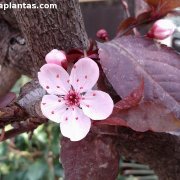Care of the tree Prunus cerasifera pisardii or Japanese Purple plum |
|
The genus Prunus, family Rosaceae, comprises 200 species of trees and shrubs native to temperate regions of the Northern Hemisphere. Some species are: Prunus cerasifera, Prunus avium, Prunus laurocerasus, Prunus domestica, Prunus mahaleb, Prunus lusitanica, Prunus spinosa, Prunus persica, Prunus dulcis, Prunus armeniaca, Prunus serrulata, Prunus cerasus, Prunus incisa. Common names: Purple-leaf Cherry plum, Japanese Purple plum. This species is native to Southeast Europe and Western Asia. They are small trees or highly branched deciduous shrubs with a compact crown that reach 8 meters (26.24 feet) in height. The leaves, reddish-garnet in color, have an ovate-sharp shape with a serrated edge and an alternate arrangement. The flowers are pink and appear before the leaves. They bloom from late winter to early spring. They produce edible fruits similar to cherries. This easy-to-grow tree is used as isolated specimens, although it can also form highly decorative hedges. Japanese Purple plum is ideal for small gardens due to its size and low maintenance. It's also used in parks and streets for its resistance to pollution in cities. Prunus cerasifera pisardii needs full sun or light shade exposure and a temperate climate. It resists occasional frosts. Purple-leaf Cherry plum is not demanding with the type of soil although it prefers it to be somewhat clayey, well drained and with organic matter. Always water moderately, waiting for the substrate to dry; Japanese Purple plum resists drought well. Fertilize in spring with humus, compost or manure. Prunus cerasifera pisardii can be lightly pruned in early autumn to control growth or maintain a compact appearance. Japanese Purple plum is resistant to the usual pests and diseases. Purple-leaf Cherry plum is propagated from seeds sown in spring or fall. |
Images of the tree Prunus cerasifera pisardii or Japanese Purple plum |
Find plants
Prunus cerasifera pisardii or Japanese Purple plum | Care and Growing
© 2026 FavThemes






